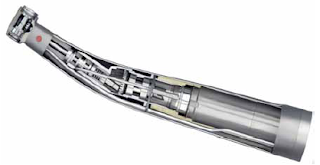 |
Former Dental Nurse breaks ranks to reveal the frightening truth about teeth whitening products >> READ HERE! |
If I have to name one thing that have revolutionized modern day dentistry then I'll say Dentist drill.
 Handpiece or drill is a sophisticated device which runs on electric motor or air pressure, The drill which you see commonly in the dental clinic is a air driven handpiece. It runs with the help of compressed air which helps in rotating the turbine which ultimately rotates the bur.
Handpiece or drill is a sophisticated device which runs on electric motor or air pressure, The drill which you see commonly in the dental clinic is a air driven handpiece. It runs with the help of compressed air which helps in rotating the turbine which ultimately rotates the bur.
Turbine is the heart of the drill, it's a kind of precision component which convert the air pressure in mechanical energy of rotation. Turbine rotates around a axis on which a bur or drill bit is fixed, as the turbine rotates bur will rotate. turbine have small fin like structures attached around it's axis to catch the air resistance and convert it into rotatory motion.
You may be thinking How fast does dentist drill rotates?
Turbine of the dental drill rotate at the free speed of 3,80,000 to 4,50,000 revolutions per minute ie rpm. This speed is measure in two categories one is free speed (when bur is not in the contact of tooth surface) and other is active speed (when bur is in contact with tooth surface). Active speed is around 1,80,000 to 2,00,000 rpm.
Yes the dental handpiece / drill have brought the revolution in modern dentistry and it have become an integral part of a dental practice.
How Does A Dentist Drill Work
Today dentists are dependent on the handpiece / drill, if drill is running smoothly then practice is running smoothly.
 Handpiece or drill is a sophisticated device which runs on electric motor or air pressure, The drill which you see commonly in the dental clinic is a air driven handpiece. It runs with the help of compressed air which helps in rotating the turbine which ultimately rotates the bur.
Handpiece or drill is a sophisticated device which runs on electric motor or air pressure, The drill which you see commonly in the dental clinic is a air driven handpiece. It runs with the help of compressed air which helps in rotating the turbine which ultimately rotates the bur.
The first air driven handpiece was made by Dr John Borden of USA 1950 and pioneering work was done by Sir Jhon Walsh in NewZealand.
Dentist drill (Air driven) consist of two main part
- The Body or shell through which air and water are supplied
- The Turbine which revolves the bur
Body or shell can be made up of brass, stainless steel, or titanium, brass is cheaper but less strong and more corrosive, steel is strong but costly, titanium is least corrosive most strong but most costly.
The body can be further divided into head and outer sheath, head holds the turbine and outer seath forms the handle and hold the inlets of air and water supply.
Rusting of the inner surface of head can be seen in handpieces due to repeated sterilization.
.jpg) |
| Turbine inside head |
You may be thinking How fast does dentist drill rotates?
Turbine of the dental drill rotate at the free speed of 3,80,000 to 4,50,000 revolutions per minute ie rpm. This speed is measure in two categories one is free speed (when bur is not in the contact of tooth surface) and other is active speed (when bur is in contact with tooth surface). Active speed is around 1,80,000 to 2,00,000 rpm.
You may think what is the need of such a high speed, answer is- Dentist have to drill or cut one of the hardest structure of the human body which is enamel.
Answer-
Coming back to the Mechanism of action - How does dentist drill work
Answer-
- Dentist presses a foot pad which is nothing but a kind of switch to on and off the drill.
- On pressing the foot pad compressed air is released and enters the drill through air inlet pipe which is attached to the drill at back end ie. coupling.
- Compressed air reaches the head part of the handpiece in a small chamber which houses the air turbine.
- In attempt to escape this compressed air rotates the turbine.
- Through various minute attachments there is facility to attach a bur to this turbine.
- When turbine rotates bur also rotates.
- This bur is used for drilling and cutting tooth structure.

